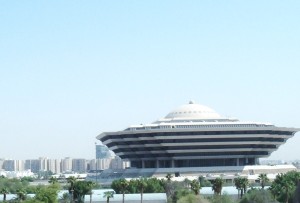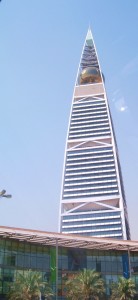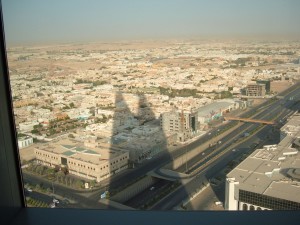 Until the exploitation of oil in the 60’s, Riyadh was a small town of mud brick buildings, the remains of which, on the outskirts of the modern city, are worth a visit . The capital of The Kingdom since the 80’s, Riyadh is now a sprawling city of 4 million.
Until the exploitation of oil in the 60’s, Riyadh was a small town of mud brick buildings, the remains of which, on the outskirts of the modern city, are worth a visit . The capital of The Kingdom since the 80’s, Riyadh is now a sprawling city of 4 million.

There are some stunning buildings – the Foreign Ministry looks like a huge spaceship.

The building housing the Four Seasons hotel is in a skyscraper shaped like a bishop’s mitre, The King Faisal tower – also very tall – is a needle. Most of the rest of the city is three or four storied buildings and everything is in shades of sand – ranging from cream to camel.
 Housing is in walled compounds. I am struck by the amount of greenery along the main highways and public places and more struck by the effort it takes to maintain it. With no precipitation, every plant is on drip irrigation – a gigantic undertaking. There are, of course, palm trees of all sizes, green creeping ground covers, bougainvillea, frangipani bushes, many grasses, and, most surreal – topiaried shrubs lining several highways. There are also fountains in all public places – an abundance of water. Where it comes from and how much is left, is something I definitely want to find out.
Housing is in walled compounds. I am struck by the amount of greenery along the main highways and public places and more struck by the effort it takes to maintain it. With no precipitation, every plant is on drip irrigation – a gigantic undertaking. There are, of course, palm trees of all sizes, green creeping ground covers, bougainvillea, frangipani bushes, many grasses, and, most surreal – topiaried shrubs lining several highways. There are also fountains in all public places – an abundance of water. Where it comes from and how much is left, is something I definitely want to find out.
The Embassy is located in the Diplomatic Quarter – an area set aside when the capital moved here – to isolate the foreigners and, I’m sure, keep them from contaminating Riyadh with their infidel ways. We set out each morning from our hotel in armored cars, a different route each day. Getting into the DQ with the current security concerns is quite amazing. There are red and white painted ‘jersey’ barriers – those big concrete blocks – forming a slalom course prior to the checkpoint, sandbagged, manned by Saudi military guards on armored personnel carriers with machine gun mounts. Diplomatic license plates have a special lane which gets us through fairly quickly. Everyone else goes through the check point and long lines develop in the morning. All those who work in the quarter live outside and endure this hassle daily.
Entering the DQ is nothing compared to getting into the Embassy compound. Sally ports, razor wire, man traps, slalom course, Gurkhas, more tanks, more machine guns and multiple checks – we have it all.
The DQ is about two miles by four miles in size. All the street signs are in Arabic, and the buildings, some of them quite beautiful, are all the same color and of similar fort-like construction. I would definitely need breadcrumbs to keep from getting lost. Lots of greenery-planted roundabouts and gushing fountains. Everything walled. No pedestrians on the streets. It has the eerie feeling of a high-end ghost town.
All Embassy staff are housed here in apartments or townhouses – very comfortable but jail like with bars on windows and doors and air raid sirens on roofs. Wearing an abaya is not required in the quarter, though some take that precaution. The religious police – Mutaween – have been known to come into the DQ and harass western-clad women.
No American embassy employee may travel outside the DQ unless in an armored vehicle with an Embassy driver. As all grocery and other shopping is outside the area, the burden on the motor pool is huge and they are available 24/7. The drivers are all non-Saudis – as are all but two of our other local employees. Saudi Arabia lives on imported workers – six million of them from surrounding Arab states, the Far East and Sub-Continent. Almost no Saudis will take blue-collar jobs – or white-collar jobs, for that matter.
Next – Some real Saudi women.

Leave A Comment